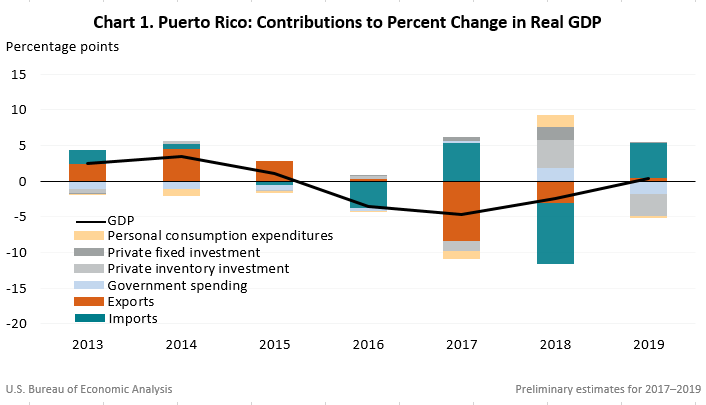News Release
Gross Domestic Product for Puerto Rico, 2019
First Official Release of GDP for Puerto Rico, 2012–2019
Real gross domestic product (GDP) increased 0.3 percent in 2019 after decreasing 2.4 percent in 2018, according to estimates released today by the Bureau of Economic Analysis (BEA). The statistics released today are BEA’s first official release of GDP for Puerto Rico. The release includes updated estimates for 2012 to 2018 that incorporate new and additional source data and methodology improvements to the prototype GDP statistics that were released in September 2020.
As shown in chart 1, the increase in real GDP in 2019 reflected an increase in exports. Although private inventory investment, government spending, and consumer spending declined, these decreases were largely offset by a decrease in imports, which is a subtraction item in the calculation of GDP (table 1.4).
Pharmaceuticals and organic chemicals were the largest contributors to both the growth in exports and the decline in imports in 2019 (table 3.4). Exports increased 0.7 percent, while imports decreased 9.1 percent (table 3.3). The primary contributor to the decrease in private inventory investment was the chemical manufacturing industry, which includes pharmaceutical manufacturers.
Government spending decreased 11.4 percent in 2019 as spending on disaster recovery activities slowed (table 1.3). The largest decline was in gross investment in structures by the central government as major repairs to the power grid, which was damaged in 2017 by Hurricanes Irma and Maria, were completed in 2018 (table 4.1.3).
Consumer spending decreased 0.5 percent in 2019. Purchases of durable goods decreased 3.6 percent as disaster-related insurance payouts and government payments to households, which supported consumer spending in 2018, declined (table 2.3).
Puerto Rico GDP includes production owned by nonresidents, such as nonresident multinational enterprises. In Puerto Rico, subsidiaries of large nonresident multinational enterprises operate within the pharmaceutical manufacturing industry, as well as the medical device manufacturing and computer services industries. The Box in the Technical Note provides an update of research provided in 2020 that shows GDP excluding exports, imports, and inventory investment associated with these intellectual property-intensive industries.
As part of the transition from prototype to official statistics, BEA is instituting a routine release and update cycle for these estimates that is similar to other BEA data products. Much of the source data that BEA uses to prepare the Puerto Rico GDP estimates is drawn from administrative or survey data that, over time, will provide more comprehensive or relevant information. For the earliest “preliminary” estimates, the GDP statistics are based on partial information sets that are supplemented with less comprehensive or less direct indicators of economic activity. Due to lags in the availability of source data, in particular for private inventory investment and central government spending, the estimates presented in the news release are preliminary for 2017–2019. For more information on updates to previously published estimates, see the Technical Note.
Although federal economic data collection alone is not sufficient to measure all components of Puerto Rico GDP, the federal economic data sets that include Puerto Rico are the foundation that makes the estimation of Puerto Rico GDP possible. These data sources include the Economic Census of Island Areas, U.S. Trade with Puerto Rico and U.S. Possessions (FT895), U.S. International Trade in Goods and Services (FT900), the Quarterly Census of Employment and Wages, the Decennial Census of Population and Housing, the Puerto Rico Community Survey, and various price index programs from the Bureau of Labor Statistics. More information on these data sets is available in the Fact Sheet: Federal Economic Data That Make BEA’s Puerto Rico GDP Estimate Possible on BEA’s website.
For more information on the data sources and methodologies that underlie the estimates, see the Summary of Methodologies: Puerto Rico Gross Domestic Product on BEA’s website.
Because Puerto Rico is not included in most of the major surveys used by BEA to estimate U.S. national GDP, the support and assistance provided by the government of Puerto Rico has been critical to the successful production of these estimates. BEA appreciates the information provided by numerous organizations and individuals in Puerto Rico, including (in alphabetical order) the following:
- The Economic Development Bank for Puerto Rico, Office of Economic Studies
- The Office of the Commissioner of Insurance of Puerto Rico
- The Puerto Rico Department of Economic Development and Commerce
- The Puerto Rico Department of Labor and Human Resources
- The Puerto Rico Department of the Treasury
- The Puerto Rico Electric Power Authority
- The Puerto Rico Industrial Development Company
- The Puerto Rico Institute of Statistics
- The Puerto Rico Planning Board
